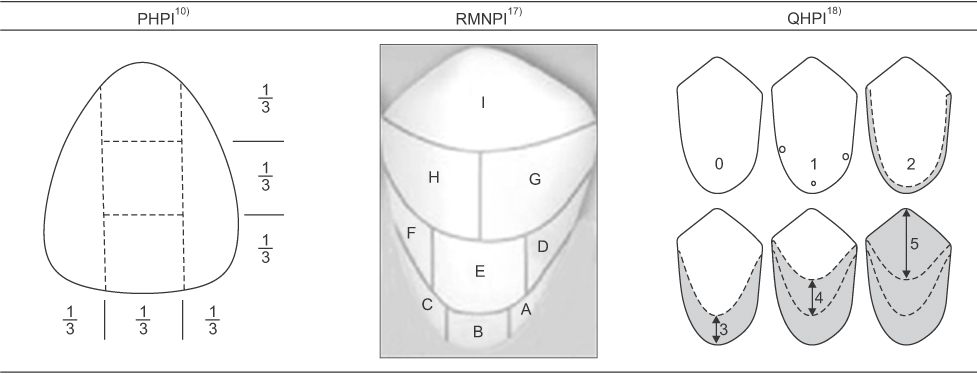J Korean Acad Oral Health.
2017 Dec;41(4):262-266. 10.11149/jkaoh.2017.41.4.262.
Comparison of traditional dental plaque indices with real stained plaque area
- Affiliations
-
- 1Department of Preventive and Community Dentistry, School of Dentistry, Pusan National University, Yangsan, Korea. jsh0917@pusan.ac.kr
- 2BK21 PLUS Project, School of Dentistry, Pusan National University, Yangsan, Korea.
- KMID: 2400242
- DOI: http://doi.org/10.11149/jkaoh.2017.41.4.262
Abstract
OBJECTIVES
The aim of this study was to compare Plaque Percent Index (PPI), calculated by Patient Hygiene Performance Index (PHPI), Rustogi's modification of the Navy Plaque Index (RMNPI), and the Quigley & Hein Plaque Index (QHPI), with visual assessment.
METHODS
Ninety-six subjects, aged between 30-65 years, were examined; twenty subjects were included in the final analysis. The subjects' teeth were stained and photographed. Dental coloring and intraoral camera photography were performed by a single examiner. The oral images obtained were analyzed using Image J to measure the area of dental plaque. The values of PHPI, RMNPI, and QHPI were calculated twice. Statistical analyses were performed using descriptive statistics, chi-square test, and Pearson's correlation coefficient.
RESULTS
The results of the correlation analyses of PPI with PHPI, QHPI, and RMNPI were as follows: for PHPI, the correlation coefficient (r)=0.584; for QHPI, r=0.689; and for RMNPI, r=0.729. Further, the kappa indices of PHPI, QHPI, and RMNPI were 0.810, 0.677, and 0.590 respectively.
CONCLUSIONS
Among RMNPI, QHPI, and PHPI dental plaque indices, RMNPI and QHPI showed a high degree of correlation with the actual stained dental plaque area; on the other hand, PHPI showed the highest kappa index.
Figure
Reference
-
1. Fejerskov O, Nyvad B, Kidd EAM. Dental caries: what is it. In : Fejerskov O, Nyvad B, Kidd EAM, editors. Dental caries. 3th ed. West sussex: John Wiley & Sons, Ltd;2015. p. 8–10.2. Axelsson P. Etiology of periodontal diseases. In : Axelsson P, editor. Diagnosis and risk prediction of periodontal diseases. 3th ed. Karlstad: Quintessence Publishing Co, Inc;2002. p. 1–91.3. Marsh PD, Martin MV, Lewis MAO, Williams DW. Dental plaque. In : Marsh PD, Martin MV, Lewis MAO, Williams DW, editors. Oral microbiology. 5th ed. Edinburgh: Churchill livingstone ELSEVIER;2009. p. 74–102.4. Listgarten MA. The structure of dental plaque. Periodontol 2000. 1994; 5:52–65.
Article5. Kim EJ. Study on the reduction effects on oral microorganisms through the different methods of controlling dental plaque [master's thesis]. Seoul: Dankook University;2003. [Korean].6. Tan AES. The role of visual feedback by a disclosing agent in plaque control. J Clin Periodontol. 1980; 7:140–148.
Article7. Arnim SS. The use of disclosing agents for measuring tooth cleanliness. J Periodontol. 1963; 34:227–245.
Article8. Block PL, Lobene RR, Derdivanis JP. A two-tone dye test for dental plaque. J Periodontol. 1972; 43:423–426.
Article9. PL Block JP Derdivanis . Dental Plaque Disclosing Agent. US Patent 3-723-613. US Patent Office. 1973.10. Arlon GP, John VH. A method for evaluating oral hygiene performance. Public health reports. 1968; 83:259–265.
Article11. Rustogi KN, Curtis JP, Volpe AR, Kemp JH, McCool JJ, Korn LR. Refinement of the modified navy plaque index to increase plaque scoring efficiency in gumline and interproximal tooth areas. J Clin Dent. 1992; 3:C9–C12.12. Quigley GA, Hein JW. Comparative cleansing efficiency of manual and power brushing. J Am Dent Assoc. 1962; 65:26–29.
Article13. Ismail AI. Clinical diagnosis of precavitated carious lesions. Community Dent Oral Epidemiol. 1997; 25:13–23.
Article14. Söder PO, Jin LJ, Söder B. Computerized planimetric method for clinical plaque measurement. Scand J Dent Res. 1993; 101:21–25.
Article15. Han SY, Kim BR, Ko HY, Kwon HK, Kim BI. Assessing the use of quantitative light-induced fluorescence-digital as a clinical plaque assessment. Photodiagnosis Photodyn Ther. 2016; 13:34–39.
Article16. Verran J, Rocliffe MD. Feasibility of using automatic image analysis for measuring dental plaque in situ. J Dent. 1986; 14:11–13.
Article17. Cugini M, Thompson M, Warrens PR. Correlations between two plaque indices in assessment of toothbrush effectiveness. J Contemp Dent Pract. 2006; 7:1–9.
Article18. Bay I, Kardel KM, Skougaard MR. Quantitative evaluation of the plaque-removing ability of different types of toothbrushes. J Periodontol. 1967; 38:526–533.
Article19. McHugh ML. Interrater reliability: the kappa statistic. Biochem Med (Zagreb). 2012; 22:276–282.
Article20. Axelsson P. Professional mechanical toothcleaning. In : Axelsson P, editor. Preventive materials, methods, and programs. 4th ed. Karlstad: Quintessence Publishing Co, Inc;2004. p. 103–103.21. Claydon N, Addy M. The use of planimetry to record and score the modified navy index and other area-based plaque indices. A comparative toothbrush study. J Clin Periodontol. 1995; 22:670–673.
Article22. Mander CI, Mainwaring PJ. Assessment of the validity of two plaque indices. Community Dent Oral Epidemiol. 1980; 8:139–141.
Article
- Full Text Links
- Actions
-
Cited
- CITED
-
- Close
- Share
- Similar articles
-
- Comparison of Clinical Characteristics of Fluorescence in Quantitative Light-Induced Fluorescence Images according to the Maturation Level of Dental Plaque
- Analysis of Dental Plaque Removal Effect by Floss Type Using QLF-D
- Utility of intraoral scanner imaging for dental plaque detection
- A Novel Dental Plaque Index Using Intraoral Camera Images
- Milia en Plaque



